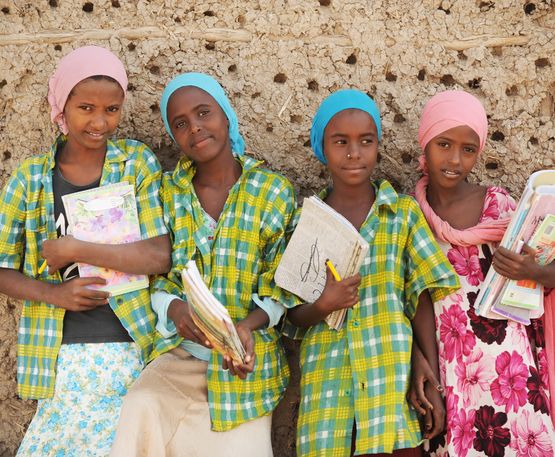The connection between “Human Mobility in the Context of Climate Change (HMCCC)” is increasingly recognized as a pressing issue of our times. For years, the ACT Alliance and Bread for the World have been active for those facing the worst impacts of climate change, those who remain, those on the move and those who will be on the move. The publication Addressing the Protection Gap - Human Mobility and the Climate Crisis in International Frameworks provides an insight into the topic and identifies relevant frameworks in the areas of climate change, migration, humanitarian response and applicable international law. Furthermore, it identifies gaps and opportunities for action to close the existing protection gap.
Human Mobility in a World of Climate Crisis
The Sixth Assessment Report of the Intergovernmental Panel on Climate Change (IPCC) points out that 3.3 to 3.6 billion people worldwide currently live in environments vulnerable to climate change. Especially people in the Global South are constrained by their geographic location but also by limited coping and adaptation capacities. Only in 2020 30.7 million people were displaced due to climate related disasters. This is in addition to an unknown number of people who had to leave their homes due to slow-onset processes such as desertification or sea-level rise. Climate Change will significantly accelerate this trend. Even under the most optimistic scenarios, slow-onset processes and extreme weather events will drastically impact the habitability of the most affected areas of the world (IPCC 2018).
Climate Crisis as threat amplifier
In this process, the climate crisis amplifies and interacts with already existing threats and security risks, exacerbating humanitarian crises, social and political conflicts, economic insecurities and existing vulnerabilities compelling more people to move. Women, children, LGBTIQ, the elderly, people with disabilities and members of ethnically and racially discriminated groups have the fewest resources to prepare for and protect against the impacts of climate change and disasters.
Human Mobility can be an adaptation strategy
Human mobility can be an adaptation and risk reduction strategy and may help reduce vulnerability, if human and social rights are protected and if movement is voluntary, safe, and orderly. This was confirmed in the 6th IPCC-Assessment Report on Vulnerability and Adaptation. However, international protection and the freedom to move remains severely restricted. The lack of regular pathways for migration forces people to take life-threatening migration routes and exposes them to human rights violations, labor exploitation and gender-based violence, among other threats. Planned relocation processes are often accompanied by non-economic loss and damage, human rights violations, including economic and cultural rights. Internal Displacements are not sufficiently addressed and lack financial resources and institutional capacities.
Tailored solutions are necessary to respond to the needs of affected populations, especially people living in vulnerable situations should not left behind.
The Analysis “Addressing the Protection Gap - Human Mobility and the Climate Crisis in International Frameworks”
This analysis presents iterative steps towards the development of a solid basis for a better understanding and advocacy that puts the rights and agency of those affected at its core. To this end, the study introduces key concepts and provides insight into climate change impacts and existing mobility patterns in different regions. In a second step, the analysis identifies the key actors, relevant legal and policy frameworks and instruments in the areas of climate action, disaster risk reduction, international protection and migration management. It seeks to highlight existing legal and technical gaps and challenges and assesses ongoing processes. The analysis indicates entry points for civil society participation and develops recommendations on human mobility in the context of climate change for advocacy.
The study shows that people on the move due to climate change, as well as those at risk of displacement, are currently left to fend for themselves without sufficient protection to ensure their rights. International agreements and processes are on the way, but progress is very slow and they are far from implementation. Moreover, most of the existing instruments and processes are regionally fragmented and not legally binding. Protecting those who move within and across borders due to climate change impacts remains a major obstacle. And rather than facilitating human mobility, migration is increasingly seen as a security threat, or at least politically undesirable, by a large number of states. Moreover existing frameworks and instruments are still organized in silos, and fail to recognize the multicausal and interrelated dimensions of HMCCC. Human Mobility is still not sufficiently included in climate policy, risk reduction and humanitarian response and there is still far too little funding available, especially with regard to migration as adaptation.
In addition, the study points out that affected local communities in particular have little access to information, political processes, and appropriate sources of funding. However, this is necessary in order to develop climate and migration policies that are focused on the people's needs and that enable local approaches to solutions. Therefor ACT Alliance and Bread for the World call for following actions.
Policy recommendations at a glance
1. Cross-Cutting Issues: Beyond Silos, Toward Holistic, Rights-Based Approaches
- States should consistently adopt a people-centered and human rights-based approach in all measures regarding HMCCC and take situations of vulnerability into account.
- Meaningful and effective participation of affected communities and civil society organizations should be ensured in all policies around HMCCC with a view towards promoting local-approach solutions.
- Gender-responsive approaches should guide emerging policies to account for the differentiated impacts of climate change on the mobility of people by their age, gender and diversity.
- Silos between different policy fields must be bridged to ensure a complementary and holistic approach to displacement, planned relocation and migration.
2. Human Mobility in Climate Policy
- States should ensure the full implementation of the Paris Agreement to keep global warming at 1.5°C and harmonize their reduction of greenhouse gas emissions with the United Nations Framework Convention on Climate Change (UNFCCC) goals.
- States should address mobility-related gaps in national planning processes on adaptation, disaster risk reduction, loss and damage and scale up their ambition to fulfill mitigation, adaptation, loss and damage and finance commitments.
- Stakeholders should include human mobility more effectively in UNFCCC processes, through strengthening existing international initiatives, and including HMCCC in workstreams on adaption as well as loss and damage.
3. HMCCC in Migration and Displacement Policies
- States should enhance resilience to prevent displacement and distress migration through effective access to social protection measures to help address inequities. Nonetheless, the right to mobility should not be denied.
- Existing regional initiatives addressing transboundary disasters and slow-onset weather events should be strengthened and expanded.
- Human rights-based legal and policy instruments should respond to the needs of people displaced or at risk of displacement by climate-induced disasters, both in sudden-onset and slow-onset scenarios.
- Protection measures and durable solutions for internally displaced persons should be strengthened by fully adopting and implementing existing guidelines and including them in disaster risk reduction plans and development strategies.
- States should improve the protection of migrants in situations of vulnerability by applying more predictable and human rights-based frameworks centered around the provision of both nondiscretionary and discretionary pathways for regular migration, including those based on humanitarian and compassionate grounds.
- Additional protocols to protect climate-induced cross-border migration should be adopted based on international human rights obligations.
4. Financing HMCCC
- Industrialized countries must fulfil their climate finance commitments under the UNFCCC and Paris Agreement, and ensure that 50% of funds support adaptation measures.
- Climate finance should support action on human mobility. States should be supported by the UNFCCC in addressing HMCCC. Therefore, the financial architecture needs to be improved to meet different needs, e.g., through differentiated, targeted funding streams.
- Human mobility needs to be promoted as a pillar of proposals to international climate financing instruments, including adaptation scenarios. According to the polluter-pays-principle and to respond to climate justice, the decided Loss and Damage Fund should be set up needs-based and secure additional funding to mitigation, adaptation, Official Development Assistance (ODA) and humanitarian aid.
- Funding needs to be linked more effectively with sources outside the UNFCCC process and aligned with climate justice efforts, including ODA and humanitarian funding streams.
- The politization of HMCCC should be resisted. Conditionalities designed to force countries of origin to reduce migration numbers must be avoided. Existing regional initiatives should be strengthened and expanded. Additional protocols to protect climate-induced cross-border migration should be adopted based on international human rights obligations.
As we have observed at the last UN Climate Conference COP27 in Egypt, the interest in the topic of HMCCC is increasing as the number of side events are rising. Especially side events linking the need for a Loss and Damage Fund securing funding for HMCCC made clear it is crucial to address the diverse protection needs of people at risk of climate-induced displacement in a holistic manner.
However, the topic itself or further important issues such as live saving legal pathways are not negotiated with the UNFCCC process. They are discussed in other policy fields and processes for example under the UN-Migration Network (UNMN).
The more important it is that civil society are putting pressure on States to come up with people-centered solutions. On 27th January 2023, Greta Thunberg and António Vittorino, Director General of the International Organization for Migration (IOM), called for immediate action and solidarity to tackle the impacts of climate change on human mobility and to find solutions. Following this call, we hope that the publication presented by ACT Alliance and Bread for the World will contribute to this effort.
This blog was written together with Dr. Katherine Braun.





